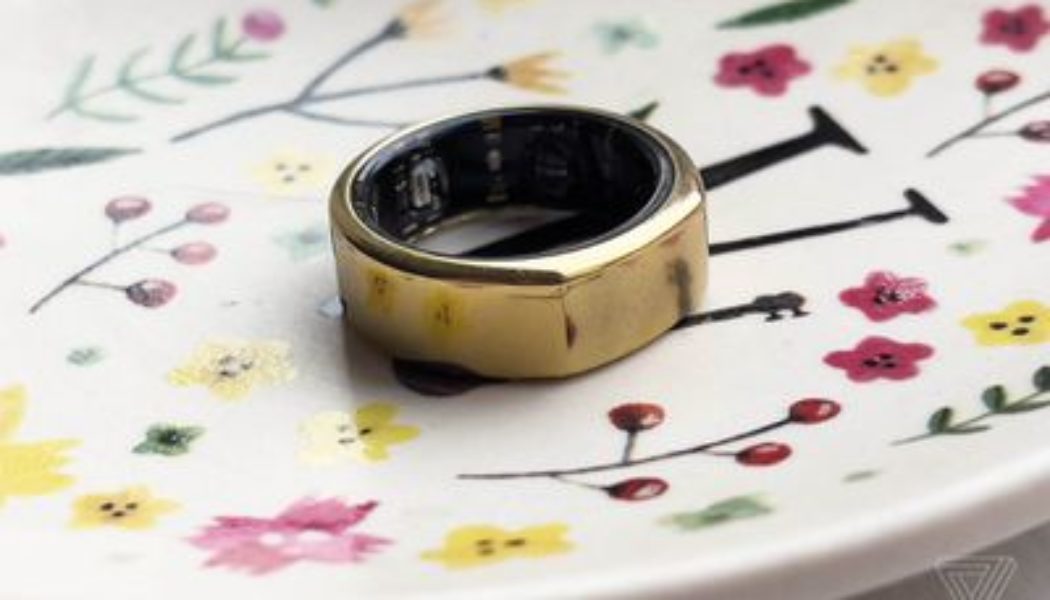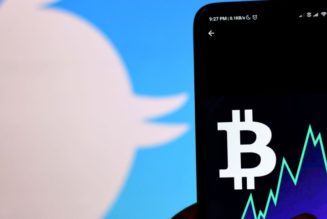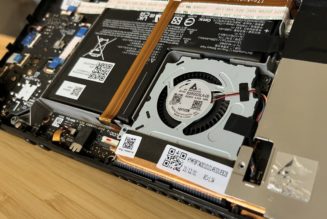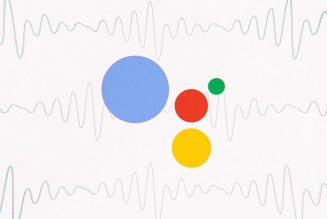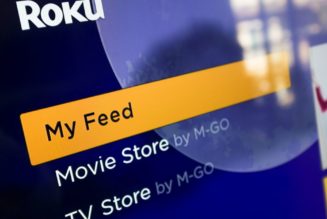Last year, it seemed like the Oura Ring was everywhere. Researchers were studying whether the smart ring (and other wearables) could one day detect illness, and right on cue, the NBA announced it bought 2,000 Oura Rings to monitor athletes. Prince Harry has been a fan for years, and celebrities like Jennifer Aniston and Kim Kardashian West have also been spotted wearing the sleep tracker. That’s already a lot of buzz for a niche gadget, but the third-generation Oura Ring also adds ambitious new features like period prediction and blood oxygen. The question is whether it’s worth committing to a $299 smart ring that now requires a monthly subscription.
For a ring with such fashionable devotees, it’s quite plain. My gold review unit isn’t too far off from what Frodo schlepped to Mordor. It also comes in silver and black, as well as a matte black version called “stealth.” So while you won’t turn heads, it’s perfect at blending seamlessly into your life. It doesn’t catch on your clothes, it’ll never buzz when you get notifications, and it’s way more comfortable than wearing a smartwatch 24/7. Most days, even I forgot it was a smart ring.
This kind of disappearing act is no easy feat. The new Oura Ring packs in four more temperature sensors for a total of seven, a new green LED heart rate sensor, and an SpO2 sensor for monitoring blood oxygen levels. That’s on top of the battery and accelerometers. (If you look at the inside of the ring, you can catch a glimpse of how tiny these sensors are.) So while the ring is a little wider than I’d prefer — especially for petite fingers or smaller hands — it’s a fair trade-off considering where the tech is at today.
While it’s impressive Oura crammed this much into such a small form factor, it’s not without its quirks. Unlike a normal ring, you have to check if the sensors are positioned correctly if you want the most accurate metrics. Since you’re wearing it all day and night, you also have to be diligent about keeping the sensors clean. Fit is also important since it isn’t adjustable. You rarely need to measure your wrist to buy a smartwatch, but for the ring, you have to wait two to seven days for a free sizing kit. Oura then recommends you test a dummy ring for at least a day before placing an order. But like a smartwatch, the ring needs to be charged. It takes about two hours to get up to 100% battery, and you’ll get about a week on a single charge with normal use.
:no_upscale()/cdn.vox-cdn.com/uploads/chorus_asset/file/23035230/vsong_211117_4890_0010.jpg)
The Oura Ring bills itself as a sleep and recovery tracker. It literally doesn’t do anything else (yet). The app centers around three scores: readiness, sleep, and activity. Each is calculated based on the heart rate, temperature, and activity data collected by the ring. A high score is good, while a low score means you might need to take it easy or reevaluate your habits. That’s the gist, and you could happily ignore all the other data it throws your way. But if you want more insight, prepare to do a lot of reading.
Take your sleep score. Oura determines that by looking at factors such as total sleep, REM sleep, and deep sleep — fairly typical sleep metrics that other wearable devices provide, too. Then there are also more novel metrics like “timing,” which refers to the midpoint of your total sleep falling between midnight and 3AM. Likewise, your readiness score uses something called “recovery index,” or the time it takes for your resting heart rate to stabilize during sleep. Thankfully, each of these metrics comes with little explainers as to why they matter.
These three scores are at the core of the Oura experience. However, the third gen’s new sensors add even more data to the mix. Previously, the ring only measured your heart rate when sleeping. But with the new green LED, you can now track your daytime heart rate. That introduces new terms, like restorative time, and graphs of heart rate trends. Restorative time refers to periods of relaxation where the ring detects your heart rate is low and, strangely enough, your hands are warm. (Oura’s chief of product, Chris Becherer, says this is because skin temperature increases when you’re more relaxed.) There’s also a guide so you can interpret what patterns you’re seeing. For instance, a low, flat daytime heart rate pattern is called an “Open Ocean” and shows you’ve had a chill day. Meanwhile, a hammock-shaped heart rate curve indicates your body recovered well during the night. It’s a lot to take in, but Oura gets kudos for including both bite-sized and in-depth explanations to give you more context.
:no_upscale()/cdn.vox-cdn.com/uploads/chorus_asset/file/23024684/IMG_2083_copy.png)
But is it accurate? Daytime heart rate monitoring was in line with other trackers. In random spot checks, it was within five beats per minute of what I was getting on my Apple Watch Series 7. There were times where they weren’t in sync, but that usually evened out after a few seconds. Basically, the Series 7 will get you a faster real-time heart rate, but Oura’s daily data is presented in a more digestible format. I’m also tickled that the Oura Ring saw my nightly Pokémon sessions as restorative time.
As for sleep tracking, some wearables I’ve tested have struggled to tell when I’m awake at 4AM because the cat is yowling at the moon. For my fellow insomniacs, some trackers count those sleepless hours spent staring at the ceiling as sleep. I didn’t have that problem here. It was able to tell when I left the bed for midnight snacks and correctly identified when I was awake but trying to fall back asleep. I can’t tell you how accurate the sleep stages data is, however, as I don’t have access to clinical equipment. But my sleep data did correspond to what I got on the Sleep Cycle app on my phone and consistently outperformed the Withings ScanWatch I was testing alongside the Oura.
:no_upscale()/cdn.vox-cdn.com/uploads/chorus_asset/file/23024929/IMG_2086_copy.png)
When I reviewed the second-gen Oura Ring, the readiness score was hit-or-miss. Some days, it told me to take it easy when I felt fine. Others, I was a walking trainwreck and was told to challenge myself. This time around, however, it seems to have gotten better at recognizing bodily stress. I was sick for a week, and my readiness scores, which were in the high 70s–80s, plummeted to the 50s–60s. I also appreciated the ability to turn on a “rest mode,” which shuts off your activity score and prioritizes your readiness and sleep. More fitness trackers should follow Oura’s lead.
Along that line, Oura’s activity score emphasizes weekly activity over arbitrary daily goals. It’s OK if you’ve been chained to your desk all day — you won’t get shamed for it. Instead, your score will only start to dip if you don’t meet your goals three or more days in a week. It also accounts for your training load and will adjust your daily calorie burn target depending on your readiness score.
Another neat feature is quantified meditation sessions. I normally pass on woo-woo guided mindfulness features, but Oura caters to data nerds. After each session, you can view how it impacted your heart rate, heart rate variation (HRV), and skin temperature. Just this week, the company also added a new Explore tab to the app, which organizes audio and video content and provides more educational reading.
As for all the marquee features like SpO2 and period predictions — I’d love to tell you about my experience, but I can’t.
I did, however, get a demo of the workout heart rate tracking feature. Based on what I saw, workout heart rate tracking is minimalistic and will initially support just running, walking, and cycling. The record screen doesn’t show any metrics — which is good for distraction-free exercise — but will show a summary of your stats, route, splits, and heart rate once the activity is finished. Until then, you can import workouts from Apple Health and Google Fit (or any app like Strava that integrates with those APIs).
:no_upscale()/cdn.vox-cdn.com/uploads/chorus_asset/file/23024725/IMG_2078.PNG)
Period predictions are live and in beta, but I’ve only had this device for three weeks, and Oura recommends at least two months of continuous data. In the meantime, the app will use a combination of skin temperature data, user feedback, and the calendar method for initial predictions. TL;DR — I won’t be able to see how accurate Oura’s period predictions are for several months.
The feature also won’t be available at launch if you use contraceptives, as Becherer says the Oura team is still conducting additional testing. Current Oura users might be able to skip that two-month wait if they’ve got enough data banked, but only if and when they upgrade. This feature won’t come to Oura Ring Gen 2 owners.
This sums up why the Oura Ring can be frustrating. Oura’s looking far off into the future of wearables, and it’s counting on its customers to feel like the wait is worth it. You can see that in how Oura participates in several studies to see if it can be used to detect illness and predict pregnancy. In conversations with Oura CEO Harpreet Rai and Becherer, both emphasized this is a baby step toward more ambitious women’s health features and research.
It also means much of what makes the ring cool may be invisible to the average person. Becherer confirmed that the new sleep algorithms are a back-end update, and you won’t see any UI change in the app. Your data will simply be more accurate. He also told me that there’s “nothing we can share on SpO2 Sensing right now” but that the feature would launch in 2022. For each of Oura’s available features, you’ll get the best results only if you wear it every day for months. That’s a big commitment, and if you’re going to buy in, it has to be something you’re okay with.
:no_upscale()/cdn.vox-cdn.com/uploads/chorus_asset/file/23035228/vsong_211117_4890_0008.jpg)
It doesn’t help that Oura is switching to a subscription model. The company says it’s doing so precisely because it has such ambitious plans in this space. Unfortunately, the research that Oura (as well as Apple and Fitbit) partake in is expensive, and increasingly, one-time hardware sales aren’t keeping the lights on for smaller companies. It’s also where wearables are headed. Fitbit has Fitbit Premium, Apple introduced Fitness Plus, and Whoop — another recovery tracker — requires a $30 monthly subscription.
Compared to those, Oura membership is on the affordable side. You get six months free, and after that, it’s $5.99 a month. Current Oura ring owners also get a free lifetime membership if they upgrade — and if they don’t, they won’t get charged extra. Also, Oura says on its FAQ page that if you cancel or choose not to subscribe, you’ll still be able to see your readiness, sleep, and activity scores.
If you’re a diehard Oura user, you should upgrade and take advantage of that free lifetime membership before it expires on November 29th. For everyone else, it boils down to whether you’re ready to commit. Whoop is cheaper in the short term, but it tips in Oura’s favor if you’re in it for the long haul. A cheaper Fitbit will also get you excellent sleep tracking and recovery metrics, on top of other smart features like notifications and contactless payments.
So is the Oura Ring worth it? If recovery is important to you, but you prefer analog watches or you don’t find wrist-based trackers comfortable, then I’d say yes. Unlike the failed Motiv Ring, it’s not trying to do too much. It’s trying to be an excellent health tracker, and on that front, few others do it better.
Photography by Victoria Song / The Verge
